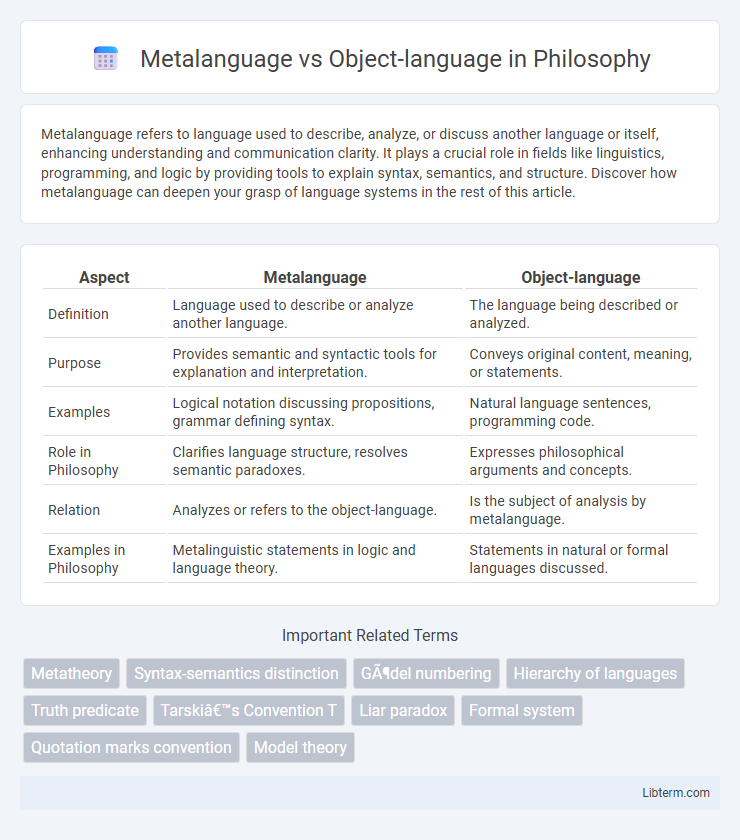Metalanguage refers to language used to describe, analyze, or discuss another language or itself, enhancing understanding and communication clarity. It plays a crucial role in fields like linguistics, programming, and logic by providing tools to explain syntax, semantics, and structure. Discover how metalanguage can deepen your grasp of language systems in the rest of this article.
Table of Comparison
| Aspect | Metalanguage | Object-language |
|---|---|---|
| Definition | Language used to describe or analyze another language. | The language being described or analyzed. |
| Purpose | Provides semantic and syntactic tools for explanation and interpretation. | Conveys original content, meaning, or statements. |
| Examples | Logical notation discussing propositions, grammar defining syntax. | Natural language sentences, programming code. |
| Role in Philosophy | Clarifies language structure, resolves semantic paradoxes. | Expresses philosophical arguments and concepts. |
| Relation | Analyzes or refers to the object-language. | Is the subject of analysis by metalanguage. |
| Examples in Philosophy | Metalinguistic statements in logic and language theory. | Statements in natural or formal languages discussed. |
Introduction to Metalanguage and Object-language
Metalanguage refers to a language used to describe, analyze, or discuss another language, known as the object-language. In formal semantics and linguistics, metalanguage contains terms and rules for talking about the structure, meaning, and use of the object-language without ambiguity. Understanding the distinction between metalanguage and object-language is essential for clarifying how linguistic theories and logical systems define and interpret statements within a given language framework.
Defining Metalanguage
Metalanguage is the language used to describe, analyze, or discuss another language, known as the object-language, providing a framework for defining its syntax and semantics. It contains terms and rules that enable clear communication about the structure and meaning of expressions within the object-language, facilitating linguistic precision and avoiding ambiguity. Defining metalanguage is essential in fields such as logic, linguistics, and computer science for formalizing languages and constructing interpreters or compilers.
Understanding Object-language
Object-language refers to the language or system being analyzed or described within a metalanguage framework. It consists of the original symbols, syntax, and grammar used for communication or formal expressions in logic, programming, or linguistic analysis. Understanding object-language is crucial for interpreting statements, constructing formal proofs, and differentiating between usage and mention of terms within theoretical and practical applications.
Key Differences Between Metalanguage and Object-language
Metalanguage is the language used to describe, analyze, or discuss another language known as the object-language. The key differences include their functional roles: metalanguage provides terms and rules for interpreting or defining expressions in the object-language, which is the subject of study or discussion. While object-language consists of statements and expressions within a specific domain, metalanguage operates at a higher level to evaluate or reason about those statements.
Examples of Metalanguage in Linguistics
In linguistics, metalanguage is the language used to describe, analyze, or discuss another language, known as the object-language. Examples of metalanguage include grammatical terms such as "noun," "verb," "syntax," and "morpheme," which are employed to explain the structure and rules of the object-language. Linguistic theories like generative grammar also use metalanguage to formulate and represent linguistic concepts and transformations.
Applications of Object-language in Communication
Object-language serves as the fundamental medium in communication, enabling the expression and transmission of ideas through natural or formal languages. It is employed in various fields such as linguistics, computer science, and philosophy to construct meaningful utterances, encode instructions, and facilitate interpersonal exchanges. Its practical applications include programming languages, everyday spoken languages, and written texts that convey information without self-reference.
Why Metalanguage Matters in Analysis
Metalanguage is crucial in analysis because it provides the framework to describe, interpret, and critique the object-language, enabling clarity and precision in understanding linguistic or logical structures. By using metalanguage, analysts can define terms, formulate rules, and identify ambiguities within the object-language, thereby enhancing the rigor of semantic and syntactic evaluations. This distinction allows for meta-level reflections essential in fields like linguistics, computer science, and philosophy, where analyzing language about language leads to deeper insights and improved communication.
Metalanguage vs Object-language in Formal Logic
Metalanguage in formal logic is the language used to describe, analyze, or manipulate the object-language, which is the language being studied or formalized. Metalanguage contains the vocabulary and rules necessary to talk about syntax, semantics, and proofs of the object-language, enabling the construction of meta-theorems and the discussion of properties like consistency and completeness. Understanding the distinction between metalanguage and object-language is crucial for interpreting formal systems, as it prevents category errors and supports rigorous logical analysis.
Common Misconceptions About Metalanguage and Object-language
Common misconceptions about metalanguage and object-language often arise from confusing their distinct roles in linguistic analysis. Metalanguage is the language used to describe or analyze another language, the object-language, which is the subject of discussion or analysis. Misunderstanding this hierarchical relationship can lead to errors, such as treating metalanguage statements as if they belong to the object-language or vice versa, obscuring clarity in semantic interpretation and logical structure.
Conclusion: Importance of Distinguishing the Two
Distinguishing metalanguage from object-language is crucial for clarity in logical analysis and linguistic theory, as metalanguage provides the framework to discuss and evaluate object-language statements without confusion. Recognizing this distinction prevents semantic paradoxes and enhances the precision of formal systems, enabling effective communication about language properties and meanings. Understanding the roles of both ensures rigorous reasoning in semantics, syntax, and philosophy of language.
Metalanguage Infographic

 libterm.com
libterm.com